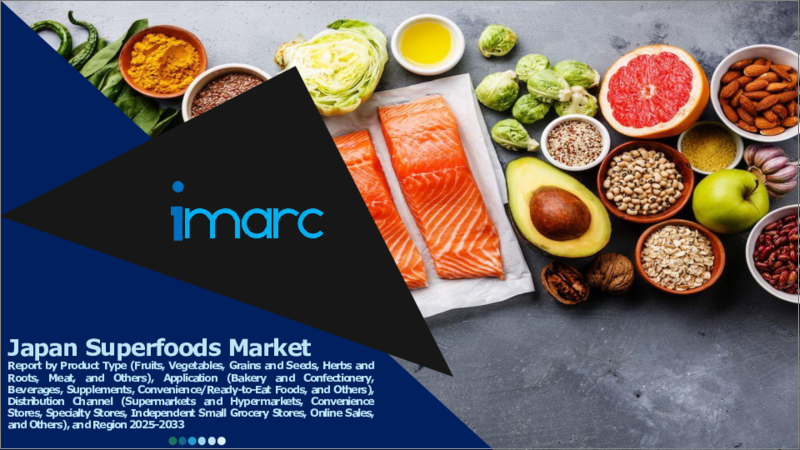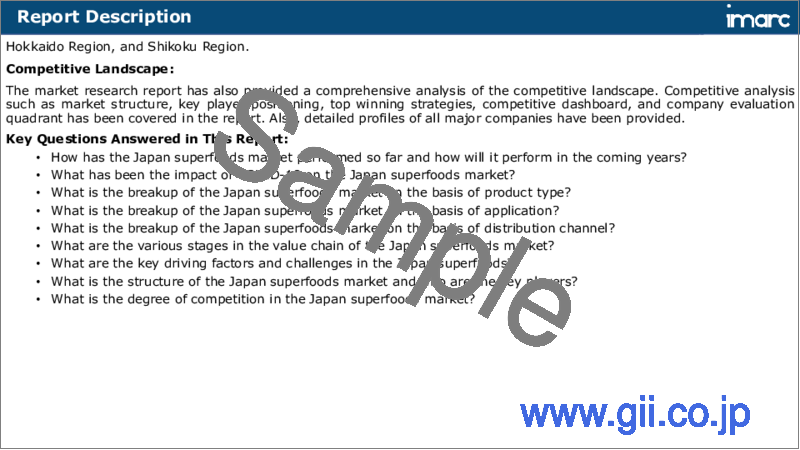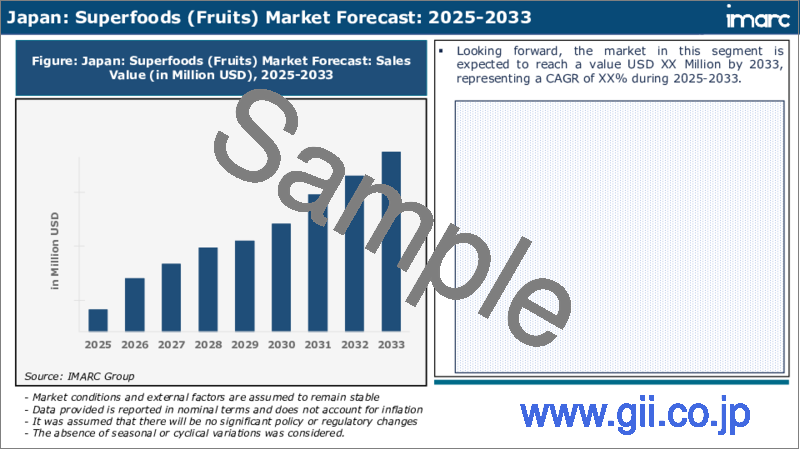|
|
市場調査レポート
商品コード
1746623
スーパーフードの日本市場:製品タイプ別、用途別、流通チャネル別、地域別、2025年~2033年Japan Superfood Market Report by Product Type, Application, Distribution Channel, and Region 2025-2033 |
||||||
カスタマイズ可能
|
|||||||
| スーパーフードの日本市場:製品タイプ別、用途別、流通チャネル別、地域別、2025年~2033年 |
|
出版日: 2025年06月02日
発行: IMARC
ページ情報: 英文 121 Pages
納期: 5~7営業日
|
全表示
- 概要
- 目次
日本のスーパーフード市場規模は2024年に109億米ドルに達しました。IMARC Groupは、2025年から2033年にかけての成長率(CAGR)は7.2%で、2033年には208億米ドルに達すると予測しています。健康とウェルネスに対する消費者の関心の高まり、国内における老人人口の増加、食品技術における急速な革新、植物ベースの食事への製品取り込みの拡大、eコマース分野の台頭などが、市場を牽引する主な要因となっています。
本レポートで扱う主な質問
- 日本のスーパーフード市場はこれまでどのように推移し、今後どのように推移するのか?
- COVID-19が日本のスーパーフード市場に与えた影響は?
- 日本のスーパーフード市場の製品タイプ別区分は?
- 日本のスーパーフード市場の用途別区分は?
- 日本のスーパーフード市場の流通チャネル別区分は?
- 日本のスーパーフード市場のバリューチェーンにおける様々なステージとは?
- 日本のスーパーフードの主要な促進要因と課題は何か?
- 日本のスーパーフード市場の構造と主要プレーヤーは?
- 日本のスーパーフード市場における競合の程度は?
目次
第1章 序文
第2章 調査範囲と調査手法
- 調査の目的
- ステークホルダー
- データソース
- 市場推定
- 調査手法
第3章 エグゼクティブサマリー
第4章 日本のスーパーフード市場 - イントロダクション
- 概要
- 市場力学
- 業界動向
- 競合情報
第5章 日本のスーパーフード市場情勢
- 過去および現在の市場動向(2019~2024年)
- 市場予測(2025~2033年)
第6章 日本のスーパーフード市場 - 製品タイプ別の内訳
- 果物
- 野菜
- 穀物・種子
- ハーブ・根茎
- 肉
- その他
第7章 日本のスーパーフード市場 - 用途別の内訳
- ベーカリー・菓子類
- 飲料
- サプリメント
- インスタント食品
- その他
第8章 日本のスーパーフード市場 - 流通チャネル別の内訳
- スーパーマーケット・ハイパーマーケット
- コンビニエンスストア
- 専門店
- 独立系小規模食料品店
- オンライン販売
- その他
第9章 日本のスーパーフード市場 - 競合情勢
- 概要
- 市場構造
- 市場企業のポジショニング
- 主要成功戦略
- 競合ダッシュボード
- 企業評価象限
第10章 主要企業のプロファイル
第11章 日本のスーパーフード市場 - 業界分析
- 促進要因・抑制要因・機会
- ポーターのファイブフォース分析
- バリューチェーン分析
第12章 付録
The Japan superfood market size reached USD 10.9 Billion in 2024. Looking forward, IMARC Group expects the market to reach USD 20.8 Billion by 2033, exhibiting a growth rate (CAGR) of 7.2% during 2025-2033. The increasing consumer focus on health and wellness, rising geriatric population in the country, rapid innovations in food technology, growing product incorporation in plant-based diets, and the emergence of the e-commerce sector represent some of the key factors driving the market.
Superfoods refer to food items that offer maximum nutritional benefits with minimal calories. They are packed with vitamins, minerals, and antioxidants. Superfoods are powerhouses of health, known to reduce the risk of chronic diseases while prolonging life. They are available in various types, including berries, green leafy vegetables, nuts, seeds, grains, and fish. Superfoods are utilized in smoothies and for fortifying meals in multiple forms, such as powders, supplements, or whole foods. They contribute to heart health, weight management, energy enhancement, and improved immunity. Superfoods offer various benefits, such as anti-aging effects, improved gut health, and reduced cancer risk. They also contain fewer calories and are high in fiber, which helps in managing weight and reducing the effects of aging. In addition to this, superfoods have the potential to improve skin quality, help in detoxification, and enhance overall vitality.
Japan Superfood Market Trends:
The increasing consumer focus on health and wellness is one of the major factors boosting the market growth. Moreover, the growing geriatric population in the country, seeking nutritional foods that support health and longevity, is fostering the market growth. Additionally, the rising innovation in food technology, leading to the development of new superfood products that cater to the busy lifestyle of consumers, is supporting the market growth. In addition to this, the heightened popularity of ready-to-eat (RTE) snacks, fortified with superfood ingredients, is providing a thrust to the market growth. Along with this, the growing incorporation of superfoods in plant-based diets as an integral component is fueling the market growth. Furthermore, the heightened demand for clean labeling and transparency in the ingredient list, prompting companies to invest in high-quality, sustainably sourced products, is strengthening the market growth. In line with this, the growing awareness about the environmental and health impacts of food sourcing practices, encouraging the adoption of superfoods as they are organic, is positively impacting the market growth. Moreover, the rising e-commerce sector in the country, facilitating easy access to a wide array of superfood products online, along with detailed product information and reviews, is amplifying the market growth. Additionally, the increasing utilization of marketing strategies in Japan, highlighting the exotic nature and health benefits of superfoods through educational campaigns, is bolstering the market growth. Along with this, the burgeoning product consumption among fitness enthusiasts due to its improved performance and recovery is providing a considerable boost to the market growth. The growing demand for superfoods like chia seeds, quinoa, and acai berries in diets, owing to their high antioxidant levels, is providing lucrative growth opportunities for the market.
Japan Superfood Market Segmentation:
Product Type Insights:
- Fruits
- Vegetables
- Grains and Seeds
- Herbs and Roots
- Meat
- Others
Application Insights:
- Bakery and Confectionery
- Beverages
- Supplements
- Convenience/Ready-to-Eat Foods
- Others
Distribution Channel Insights:
- Supermarkets and Hypermarkets
- Convenience Stores
- Specialty Stores
- Independent Small Grocery Stores
- Online Sales
- Others
Competitive Landscape:
The market research report has also provided a comprehensive analysis of the competitive landscape. Competitive analysis such as market structure, key player positioning, top winning strategies, competitive dashboard, and company evaluation quadrant has been covered in the report. Also, detailed profiles of all major companies have been provided.
Key Questions Answered in This Report:
- How has the Japan superfood market performed so far and how will it perform in the coming years?
- What has been the impact of COVID-19 on the Japan superfood market?
- What is the breakup of the Japan superfood market on the basis of product type?
- What is the breakup of the Japan superfood market on the basis of application?
- What is the breakup of the Japan superfood market on the basis of distribution channel?
- What are the various stages in the value chain of the Japan superfood market?
- What are the key driving factors and challenges in the Japan superfood?
- What is the structure of the Japan superfood market and who are the key players?
- What is the degree of competition in the Japan superfood market?
Table of Contents
1 Preface
2 Scope and Methodology
- 2.1 Objectives of the Study
- 2.2 Stakeholders
- 2.3 Data Sources
- 2.3.1 Primary Sources
- 2.3.2 Secondary Sources
- 2.4 Market Estimation
- 2.4.1 Bottom-Up Approach
- 2.4.2 Top-Down Approach
- 2.5 Forecasting Methodology
3 Executive Summary
4 Japan Superfood Market - Introduction
- 4.1 Overview
- 4.2 Market Dynamics
- 4.3 Industry Trends
- 4.4 Competitive Intelligence
5 Japan Superfood Market Landscape
- 5.1 Historical and Current Market Trends (2019-2024)
- 5.2 Market Forecast (2025-2033)
6 Japan Superfood Market - Breakup by Product Type
- 6.1 Fruits
- 6.1.1 Overview
- 6.1.2 Historical and Current Market Trends (2019-2024)
- 6.1.3 Market Forecast (2025-2033)
- 6.2 Vegetables
- 6.2.1 Overview
- 6.2.2 Historical and Current Market Trends (2019-2024)
- 6.2.3 Market Forecast (2025-2033)
- 6.3 Grains and Seeds
- 6.3.1 Overview
- 6.3.2 Historical and Current Market Trends (2019-2024)
- 6.3.3 Market Forecast (2025-2033)
- 6.4 Herbs and Roots
- 6.4.1 Overview
- 6.4.2 Historical and Current Market Trends (2019-2024)
- 6.4.3 Market Forecast (2025-2033)
- 6.5 Meat
- 6.5.1 Overview
- 6.5.2 Historical and Current Market Trends (2019-2024)
- 6.5.3 Market Forecast (2025-2033)
- 6.6 Others
- 6.6.1 Historical and Current Market Trends (2019-2024)
- 6.6.2 Market Forecast (2025-2033)
7 Japan Superfood Market - Breakup by Application
- 7.1 Bakery and Confectionery
- 7.1.1 Overview
- 7.1.2 Historical and Current Market Trends (2019-2024)
- 7.1.3 Market Forecast (2025-2033)
- 7.2 Beverages
- 7.2.1 Overview
- 7.2.2 Historical and Current Market Trends (2019-2024)
- 7.2.3 Market Forecast (2025-2033)
- 7.3 Supplements
- 7.3.1 Overview
- 7.3.2 Historical and Current Market Trends (2019-2024)
- 7.3.3 Market Forecast (2025-2033)
- 7.4 Convenience/Ready-to-Eat Foods
- 7.4.1 Overview
- 7.4.2 Historical and Current Market Trends (2019-2024)
- 7.4.3 Market Forecast (2025-2033)
- 7.5 Others
- 7.5.1 Historical and Current Market Trends (2019-2024)
- 7.5.2 Market Forecast (2025-2033)
8 Japan Superfood Market - Breakup by Distribution Channel
- 8.1 Supermarkets and Hypermarkets
- 8.1.1 Overview
- 8.1.2 Historical and Current Market Trends (2019-2024)
- 8.1.3 Market Forecast (2025-2033)
- 8.2 Convenience Stores
- 8.2.1 Overview
- 8.2.2 Historical and Current Market Trends (2019-2024)
- 8.2.3 Market Forecast (2025-2033)
- 8.3 Specialty Stores
- 8.3.1 Overview
- 8.3.2 Historical and Current Market Trends (2019-2024)
- 8.3.3 Market Forecast (2025-2033)
- 8.4 Independent Small Grocery Stores
- 8.4.1 Overview
- 8.4.2 Historical and Current Market Trends (2019-2024)
- 8.4.3 Market Forecast (2025-2033)
- 8.5 Online Sales
- 8.5.1 Overview
- 8.5.2 Historical and Current Market Trends (2019-2024)
- 8.5.3 Market Forecast (2025-2033)
- 8.6 Others
- 8.6.1 Historical and Current Market Trends (2019-2024)
- 8.6.2 Market Forecast (2025-2033)
9 Japan Superfood Market - Competitive Landscape
- 9.1 Overview
- 9.2 Market Structure
- 9.3 Market Player Positioning
- 9.4 Top Winning Strategies
- 9.5 Competitive Dashboard
- 9.6 Company Evaluation Quadrant
10 Profiles of Key Players
- 10.1 Company A
- 10.1.1 Business Overview
- 10.1.2 Product Portfolio
- 10.1.3 Business Strategies
- 10.1.4 SWOT Analysis
- 10.1.5 Major News and Events
- 10.2 Company B
- 10.2.1 Business Overview
- 10.2.2 Product Portfolio
- 10.2.3 Business Strategies
- 10.2.4 SWOT Analysis
- 10.2.5 Major News and Events
- 10.3 Company C
- 10.3.1 Business Overview
- 10.3.2 Product Portfolio
- 10.3.3 Business Strategies
- 10.3.4 SWOT Analysis
- 10.3.5 Major News and Events
- 10.4 Company D
- 10.4.1 Business Overview
- 10.4.2 Product Portfolio
- 10.4.3 Business Strategies
- 10.4.4 SWOT Analysis
- 10.4.5 Major News and Events
- 10.5 Company E
- 10.5.1 Business Overview
- 10.5.2 Product Portfolio
- 10.5.3 Business Strategies
- 10.5.4 SWOT Analysis
- 10.5.5 Major News and Events
11 Japan Superfood Market - Industry Analysis
- 11.1 Drivers, Restraints, and Opportunities
- 11.1.1 Overview
- 11.1.2 Drivers
- 11.1.3 Restraints
- 11.1.4 Opportunities
- 11.2 Porters Five Forces Analysis
- 11.2.1 Overview
- 11.2.2 Bargaining Power of Buyers
- 11.2.3 Bargaining Power of Suppliers
- 11.2.4 Degree of Competition
- 11.2.5 Threat of New Entrants
- 11.2.6 Threat of Substitutes
- 11.3 Value Chain Analysis





